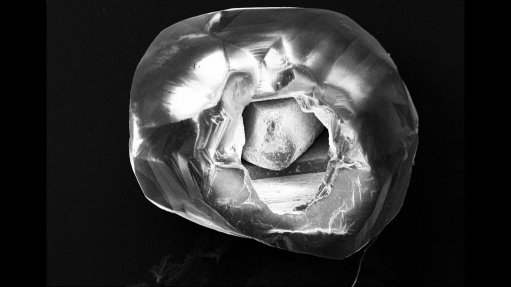
The 0.329 ct, D-colour, Type IaAB 'Beating Heart' diamond found at one of De Beers four diamond mines.
Diamond grading and analysis company the De Beers Institute of Diamonds, part of De Beers Group, reports that it has formally named an unusual diamond containing another diamond the “Beating Heart” following analysis at its facilities in Maidenhead, in the UK.
The De Beers Institute of Diamonds was alerted to the 0.329 ct, D-colour, Type IaAB diamond specimen in October 2022, when it was raised as a potentially interesting natural anomaly by De Beers Group Sightholder, VD Global, in India.
Although De Beers does not specify where exactly the diamond was mined, it says it came from one of its four global mining locations where it operates – Botswana, Canada, Namibia or South Africa.
The diamond arrived at the De Beers Institute of Diamonds facility in November 2022 and was found to have an internal cavity enclosing a smaller diamond that is trapped, yet free to move around within the space.
Instruments developed by De Beers Group Ignite, including the DiamondView and SYNTHdetect, were used in a preliminary analysis of the diamond, followed by optical and scanning electron microscopy, Fourier-transform infrared spectroscopy and fluorescence and phosphorescence imaging.
Initial conclusions suggest the cavity was formed as a result of preferential etching of an intermediate layer of poor-quality fibrous diamond.
The original core would have consisted of good-quality diamond growth. However, a subsequent layer of growth was likely poor and fibrous, followed by a further outer coating of gem-quality crystal.
At some point between its formation and travel to the surface of the Earth, the poor-quality layer etched away. Only the better quality material survived this process – the outer diamond and the core – which, in this case, led to a diamond that can freely move around within an inner space.
De Beers Group Ignite technical educator Samantha Sibley says she has “certainly never seen anything” like the Beating Heart diamond during her past 30 years in the diamond sector.
“Using the expertise of De Beers Group, we can shed light onto the formation and structure of this natural specimen and share these insights with a wider community of diamond professionals,” she says.
The Beating Heart joins a small group of similar natural diamonds, including the widely publicised Matryoshka diamond from Siberia, Russia, which was first recorded in 2019.
The Beating Heart will not be cut and polished and will instead be maintained for research and educational purposes with the consent of VD Global and with the support of De Beers Institute of Diamonds.
De Beers Institute of Diamonds global operations head Jamie Clark says the Beating Heart is a remarkable example of what can happen on the natural diamond journey from formation to discovery.
“We would like to thank VD Global for recognising this diamond's potential and acknowledging its educational and scientific potential.
“A find like this demonstrates why natural diamond formation and origin is such a fascinating area of study and why it is important to strive for advancements in testing and analysis that can contribute to our knowledge of natural diamond growth,” he says.